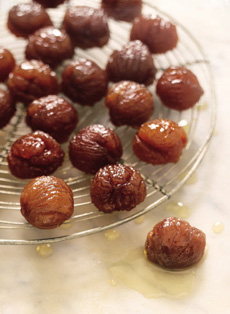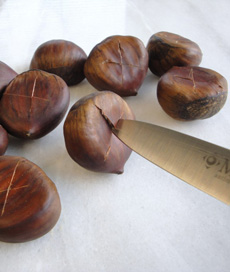TIP OF THE DAY: Candied Chestnuts
 Let us at them! Photo of marrons glacés courtesy PasticceriaCucinella.it. |
Oh, do we love marrons glacés, candied chestnuts. They have been a favorite confection from our first childhood bite, atop a scoop of vanilla ice cream in a fancy silver dish in the tea room of a long-departed department store. Then, relatives visiting France would return with boxes of them, an annual treat. Sometime later, we discovered them in local specialty stores and we began to buy our own—until they became so pricey that we learned to make them. With today’s tip, you can, too. Following the fall harvest in France and Italy, local confectioners as well as large companies prepare marrons glacés, a popular holiday gift. They can be individually wrapped in gold foil or sold in a jar covered with sugar syrup. If you read the novel La dame aux Camélias (The Lady of The Camellias) by Alexandre Dumas fils, you’ll discover that marrons glacés are the only type of confection eaten by the heroine, courtesan Marguerite Gautier. Her clients were expected to keep her in good supply. But you don’t need admirers. Create your own supply with this recipe: |
|
|
RECIPE: MARRONS GLACÉS (CANDIED CHESTNUTS) Although it takes 1-2 days to complete the recipe, actual cooking time is less than 30 minutes. For the rest of the time, the candied chestnuts soak in their sugar syrup. Ingredients For 2 Pounds |
||
|
Preparation
1. PLACE the chestnuts in a large pot with just enough water to cover the tops. Bring the water to a boil and cook the for 15 minutes; drain and discard the water. Remove the chestnuts one at a time with a slotted spoon. 2. RUB the thin, bitter membrane off the cooked chestnuts, using a clean towel or your fingers). The chestnuts will be soft, so be careful not to damage them. 3. BRING the water, sugar, and vanilla/vanilla bean to a boil in a medium pot, stirring constantly until it boils. Continue to cook the mixture for 5 minutes, stirring occasionally. The syrup will thicken. 4. ADD the prepared chestnuts to the boiling sugar syrup and stir until the syrup returns to a boil. Continue cooking, stirring frequently (and gently!), for 10 minutes. 5. POUR the candied chestnuts and syrup into a large, wide-mouth container; cover when cooled. Let the chestnuts soak in the syrup for 12 to 18 hours. 6. REMOVE the vanilla bean; the chestnuts are ready to use. You can spoon them into dessert dishes and top with whipped cream; or in shot glasses with some of the syrup. |
 Before cooking, cut an X into each chestnut. Photo courtesy ChefEddy.com. |
|
|
HOW TO ENJOY CANDIED CHESTNUTS Marrons glacés are an ingredient in many desserts and are also eaten on their own. Most fans agree that the best way to enjoy a candied chestnut is plain, with a cup of tea, as you might enjoy a bonbon or a macaron. But that’s just the beginning of a menu of delights:
The seasonal confection originated in southern France and northern Italy, where chestnut trees are plentiful. Prior to the Crusades (1095-1291 C.E.) there was no sugar in Europe. Sugar cane is native to Southeast Asia, from which it made its way to the Middle East, where it was discovered by the European crusaders. So the process of candying fruits in sugar syrup—and all of the other wonderful things we do with sugar—had to wait for the return of the crusaders to Europe. The first candied chestnut confections seem to appear at the beginning of the 15th century in the Piedmont region of Italy, among other places. The earliest written recipe is from the court of Louis XIV at the end of 17th century. In 1882 in the Ardèche département of south-central France, the first factory was built with the technology to produce marrons glacés industrially. However, many of the nearly twenty steps necessary from harvest to finished product are still performed manually, which is one reason why the treats are so pricey. [Source] |
||